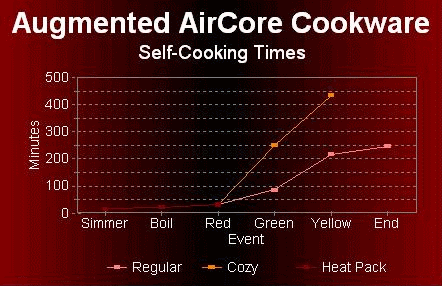We had two purposes in mind when we made the cozy for the Aircore cookware.
1. To insulate the cookware and gain longer self-cooking and hot food holding times and provide a greater range of possible dishes.
2. To provide a secure, cushioned space for the cookware when hot and in self-cook or holding mode and prevent spillage and possible injury when traveling in the RV.
Since most of the self-cooked meals would be made with the Dutch oven, we did not make the cozy to fit the frying pan with its long handle.
From the yardage store, we purchased a quilted material, about 1/4-inch thick with cotton batten filling. Our color selection was based on the tried and true method of the "least objectionable." We purchase the bare amount of material to double, make a base and a body to circle the Dutch oven (making it big enough to accommodate the handles and a 1-inch filling of fiberglass in the base and all around). The small amount of left over material was used to make a single-thickness dickie for the lid and allowing a small hole for the thermometer knob. My wife showed her skill with her sewing machine as the cozy is a thick and cumbersome thing to sew on a home machine. She did this in spite of all my attempts to help.
After stove-top cooking, the glass inner lid and metal outer lid are positioned as in normal Aircore cooking procedures. Once the thermometer has reached the desired setting, the pot is removed from the heat and placed in the cozy. The dickie is applied and the draw string pulled to encase the cookware.
We did some tests to evaluate the effectiveness of the cozy. We were very pleased with the results. We more than doubled our self-cooking times. Shortly we will have complete additional tests that include using Microcore® Heat Packs (as used in the Pyrex® Portables).

I used a fist-sized rock with 10 cups of water as the "food to be cooked." The rock has some mass and would hold heat and give more consistent and accurate results than just a pot of water. Each test was conducted with with all starting materials atthe same temperature. The stove burner was set the same so the heat saturation would be the same when the temperature marks were achieved. The time to first simmer and then boil were the same. After placing the two lids, the time to "top of the red" was also the same. At the top of the red the heat was removed.
At that point the test differed. In the baseline test, the pot was allowed to sit on the stove and the time to the temperature event markers was recorded. (Bottom of the red, top of the green, top of the yellow and bottom of the yellow.) In the cozy test, after the removal from the heat, the pot was placed in the cozy, the dickie applied and the drawstring snugged up. The cozy was then placed on a wooden cutting board to simulate the wooden base we made or the bottom of the RV sink. The wood provides additional insulation as well as protecting plastic sink parts and counter tops from the prolonged heat of the pot. The time to the identical temperature events was recorded - except for the bottom of the yellow, The test took so long that the event was missed while we were busy with other tasks.
The following day we did an actual meal, a full pot of beef stew, and the time from top of the red to top of the yellow was over 8 hours. We will have to record and observe with more an varied dishes to establish a cooking chart.
The whole rig sits in the RV sink snugly and I'm sure it will ride securely, without pitching or spilling, while the dinner for the coming night is self-cooking.





